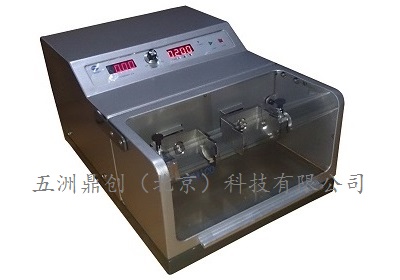QM100 high-throughput tissue grinder for animal samples
QM100 high-throughput tissue grinder
The QM100 high-throughput tissue grinder has a symmetrical pair of high-speed, large-amplitude rocker arms that can be used to grind, pulverize, mix, and cell samples in seconds and minutes with irregular impact and friction in the sample tube. Broken wall. Fine grinding, the finest can reach 5 microns.

For different samples, the QM100 high-throughput tissue grinder needs to be treated under different conditions, mainly related to grinding speed, grinding time, grinding temperature and choice of grinding beads. The following is the experimental method of the QM100 high-throughput tissue grinder for animal samples, for reference only.
Experiment 1 Insect animal tissue grinding
Experimental location: a key laboratory
Experimental materials: silkworm moth, silkworm cocoon tissue
1 Take a silkworm moth, cut it, and take a piece of body tissue (no more than 8mm in diameter) in a 2ml centrifuge tube (EP tube).
2 Add 1 5mm tungsten carbide grinding beads to the tube
3 Add the sample and the EP tube of the beads, place it on the adapter, open the lid, and add liquid nitrogen to freeze; after 3~5 minutes, remove the moisture from the sample and freeze the lid of the EP tube in time. Continue to cool in liquid nitrogen for 3 minutes.
4 Quickly place the adapter on the QM100 high-throughput tissue grinder.
Milling at 1600 rpm for 2 minutes using a QM100 high-throughput tissue grinder provides a finely divided sample powder for nucleic acid or protein extraction. (The grinding time and rotation speed can be further optimized.) The same method is feasible for silkworm cocoons, the grinding time can be increased appropriately, and the effect is very good!
Similar subjects:
Using insects as research materials; experiments requiring high-throughput extraction of nucleic acids and proteins for genetic or physiological and biochemical analysis
Experiment 2: Mammal tissue grinding
Experimental site: Key Laboratory of Biotherapy at a medical university
Experimental samples: mouse heart, spleen, liver tissue (nucleic acid extraction from animal visceral tissue)
1. The mouse tissue was frozen at -80 ° C, and the diameter was not more than 5 mm. It was placed in a 2 ml round bottom centrifuge tube.
2. Add the protease inhibitor lysate to the centrifuge tube; after 3 to 5 minutes, the tissue block is thawed in the lysate.
3, add 5mm stainless steel grinding beads 1-2
4, QM100 high-flux tissue grinding machine 1500rpm, grinding 2min
The results showed that the three tissues were basically broken, the liver tissue was lysed more thoroughly, and the heart and spleen may see fragments (such as better effect with fresh tissue), which can be solved by repeated grinding.
Similar subjects:
Samples were treated with mammalian visceral tissue; the sample volume was small and the flux was high. Experiments are needed to extract nucleic acid material from visceral tissue or to analyze physical and chemical components.
QM100 high-throughput tissue grinder is a veritable versatile laboratory sample preparation. It can quickly pulverize and homogenize samples such as hard, soft and elastic. It meets the requirements of physical and chemical analysis laboratories and is equipped with different volumes. Grinding cans of different materials can be used for dry grinding, wet grinding and freeze grinding, as well as cell disruption and DNA/RNA extraction. They are widely used in biomedicine, agriculture, food, testing and other fields.
Suction Breast Pump,Abs Breast Pump,Phthalate Free Breast Pump,Memory Function Breast Pump
NINGBO YOUHE MOTHER&BABY PRODUCTS CO.,LTD , https://www.oembreastpump.com